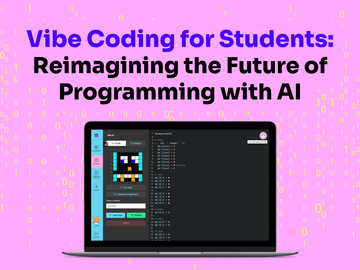
What does it mean to “learn to code” in the age of artificial intelligence? With the rise of AI tools like ChatGPT, GitHub Copilot, Cursor, Lovable and Replit just to name a few, a new approach is emerging - Vibe Coding, and it’s inevitably going to change how we teach, learn, and create with code.
Vibe Coding reimagines what it means to code. It moves the focus from memorizing complex rules and syntax to creative problem-solving, design thinking, and rapid prototyping. Just like calculators transformed math education, freeing students from repetitive calculations and allowing them to explore higher-order thinking, AI is doing the same for programming.
What Is Vibe Coding?
Vibe coding is a fresh, AI-powered approach to creating software that’s changing how we think about programming.
Instead of starting with complex syntax or memorizing rules, students begin by expressing their ideas in plain language, just like they would explain them to a friend. From there, an AI tool interprets their idea and generates the code to bring it to life. Students can then tweak, test, and refine the code with feedback from the AI, making the process highly iterative, collaborative, and creative.
It’s coding that starts with a vibe, a feeling, a vision, a story and turns it into something real.
This method mirrors how real-world developers work with AI tools today. It teaches students a more modern skillset: not just how to code, but how to communicate with AI, test ideas quickly, and think like creators and designers. AI can also be used to generate images (just like we did in this article), designs, and visual elements, opening up even more ways for students to bring their ideas to life. It’s a shift from just writing code to shaping technology with purpose and imagination.
Best of all, vibe coding is inclusive and accessible - students and their teachers don’t need to be tech experts to get started. It opens doors for more learners, especially those who may have been intimidated by traditional coding methods.
In the Vibe Coding classroom, every student becomes a maker, a problem-solver, and a storyteller, using AI to bring their ideas to life.

Why Teach Vibe Coding?
Vibe coding isn’t just a trend, it’s a powerful shift already happening in the tech industry and our teaching must change with it. In a world where AI is integrated into almost every field, teaching students how to code with AI prepares them not just for jobs, but for a future of creative problem solving, collaboration, and innovation.
Traditional coding classes often start with syntax rules and debugging errors, which can be intimidating and discouraging. But vibe coding flips the script. It invites students to start with their ideas and use natural language to bring them to life. That means more students, especially those who might not see themselves as “techy”, can engage and thrive.With vibe coding, students learn how to:
- Communicate effectively with AI tools like ChatGPT, Replit Ghostwriter, or Copilot.
- Prototype and iterate on projects quickly, testing ideas and improving them on the go, just like real developers.
- Think like designers, not just coders - solving problems creatively and building something meaningful.
At imagi we believe if introduced correctly, vibe coding can also help students deepen their knowledge of how to interpret and evaluate AI-generated code.
AI won’t replace coders, it will empower a new kind of coder.
In other words, teaching vibe coding is not just about learning to code, it’s about helping students become creative, adaptable, and AI-literate thinkers who are ready to shape the future.

Challenges and Classroom Ideas
As with any innovative teaching method, vibe coding brings both exciting opportunities and important challenges. One of the biggest questions educators face is: “If AI can write code, should we still teach students to code the traditional way?”
The answer lies in balance.
Foundational computer science knowledge, like understanding variables, loops, functions, and debugging - is still essential. But vibe coding adds a real-world, creative layer to the learning process. It shifts focus from rote syntax to problem-solving, prototyping, and iterative thinking - skills that are crucial in today’s tech landscape.
Classroom Challenges:
-
Assessing Learning: How do you evaluate student understanding if AI generates the code?
💡Tip: Ask students to explain or modify the AI-generated code to assess comprehension.
-
Equity & Access: Not all students may have equal access to the internet, devices, or AI tools.
🤝 Tip: Provide shared accounts or use school devices where possible.
-
Teacher Confidence: Many educators may feel uncertain navigating AI-assisted coding for the first time.
🍎 Tip: Offer professional development and resources to build confidence and familiarity with AI tools.
How to get started?
At imagi, we believe vibe coding is going to become a crucial part of computer science education. That’s why we’re creating a new vibe coding curriculum for students and teachers, filled with hands-on activities, lesson plans, and projects that make AI-powered coding educational, accessible, engaging, and fun.
Meanwhile, our platform and lessons already introduce the responsible use of AI through our platform’s AI Debugging Buddy feature. In these activities, students work with a safe, personalized AI tutor that serves as a thought partner in their coding journey, helping them practice debugging in Python while learning how to collaborate responsibly and effectively with AI.
Ready to give your students a taste of professional-level coding? Sign up for imagi Edu to explore our new Debugging Buddy and comprehensive CS curriculum. Plus, you'll be the first to know when our new Vibe Coding features are released!
